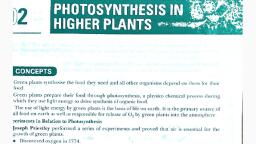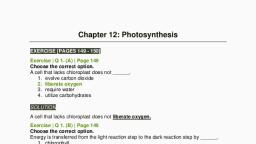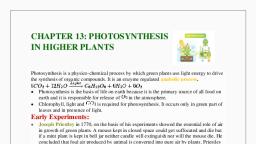Page 1 :
Accessory pigments Major Sonent, (chlorophyl-b, carotene, and (chiorophy-a), anthophiyl) —, , a |, Hundreds of pigment molecules become organised as light, harvesting complexes (LHC)., ——_ a, , woroie Vc Reaction centre, ‘Arienrae pigments ipeeccnca a, , — (Chlorophyl-b, carotene, ——, , ', , The procese/hasa in which carbon candi eanert, , (fixed) to carbohydrates using the ATP and Ni, , | produced in the ight reaction, posse, , (i see, , , , , , Photosynthesis in Higher Plants 33, , DIFFERENCES BETWEEN C, | AND C, PLANTS., , , , , , , , 's the primary carbon diaxide acceptor., 4C-compound Is the first stable product of, , t'c0, |, is about 35°C - 45°C., , aly more ecient and procuctiy is high, |, fg. maze, sugarcane, amaranth }, , , , , , , , +, ’ 7. = = ’, InternaVplant factors of External, leaves factors, dt =), ¥ v ¥ 7 + ¥ ¥ v ¥, “Age. Number Size _ Orientation Chiorophyi Light Temperature Water co,, a Content L — — concentration, Quality Duration of, , (Wavelength) Tight, , , , LY, LEARNING OUTCOMES, When this chapter is completed, the students should be able to:, * write the current equation of photosynthesis., * explain the structure of chloroplast as the seat of photosynthesis,, * define and explain the terms action spectrum and absorption spectrum., * explain the mechanism of photochemical or light reactions, electron transport and formation of, ATPs through chemiosmosis., * explain the biosynthetic phase in C, and C, plants and make a comparison between them., * explain photorespiration., * explain the law of limiting factors and the effect of various environmental and internal factors on, Photosynthesis, , a RTS Ee
Page 2 :
piology—!!, , 3s PTS, NT cONCE, pORTA\, , ant for two reasons:, , mary souree of food for all, , , , ining eT es wsponsble or the, , (a eis te ay PN the atmosphere BY, , rekesse of oxygen into, , green plants, , IS, OF PHO’ ;, ee ace in the cell organelles, a, + es hae unite mB, , cells of leaves., is a clear division of labou!, , the chloroplasts ~ the membrane system iS, the chloroy, , ible for the photochemical phase, where, hereas, , <is of ATP and NADPH occurs, wher, lok r the reduction, , ir within, , , , fo, the stroma has enzymes, schon dioxide into carbohydrates and, , , , , , , , , ‘Outer membrane, Inner membrane, Thylakoid, Granum, , Stroma lamella, , Ribosomes, , pe, , ‘Stroma, , Fig, 13.1 Diagrammatic Sketch of, Electron Micrograph of Chloroplast, , 133. PIGMENTS INVOLVED IN, PHOTOSYNTHESIS, © A chromatographic separation of the leaf, pigments shows that there are four pigments:, , chlorophyll a, chlorophyll b, carotene and, xanthophyll., , Chlorophyll ais the chief/main Pigment, associated with photosynthesis, whit, chlorophyll b, and carotenoids at as accesey, pigments. ty, The accessory pigments help in two Ways:, (i) They absorb Tight at different wavetenging, and pass it on to the reaction centre, (chlorophyll a)., (if) They also protect the chlorophy}] from, photooxidation., The absorption spectrum and action spectrum, coincide closely showing that photosynthesis, is maximum at the blue and red regions of the, spectrum., , , , , , Be Chlorophyll b, z5, , Be, , = Carotenoids, 38, , 38, , be, , Be, , 38, , BS oc, , Wavelength of light (nm)—>, , raph showing the absorption spectrum of, ae chlorophyll a, b and carotenoids,, , Light absorbed, , 400500 _—«600_—700, ‘Action spectrum, Absorption spectrum, , Wavelength of light (nm)—>, , i trum and, b) Graph showing action spectrum ar, Seorpion spectrum of photosynthesis, , , , , , , Fig. 13.2 Action Spectrum and, Absorption Spectrum, , , , 13.4, LIGHT REACTION, , ., , °, , © Photochemical phase directly depends on, , light; the pigments absorb the light energy, , and convert it into ATP., , ~ Electron transport (ATP synthesis) and, photolysis are the two major events in light, reactions., , — During this phase, water is split (photolysis), and oxygen is liberated, , — ATP and NADPH formed in this phase are, used up during the biosynthetic phase., , The pigments are organised in the thylakoid, , membranes into two discrete light harvesting, , complexes (LHCs) within photosystems,, , photosystem I (PS I) and photosystem II, , (PS I)., , Primary acceptor, , Reaction, , , , Photon, , center, ic, Pigment, >, molecules, SCOSEROS, oS, , Fig, 13.3 Light Harvesting Complex, , Each photosystem has one specific chlorophyll, aand many other pigments bound to proteins., The chlorophyll a forms the reaction centre,, where the actual reactions take place, while, the other pigment molecules form the light, harvesting system, also called antennae., , In PS 1, the reaction centre is P,y,, which is, a chlorophyll a molecule that absorbs light at, 700 nm., , In PS IL, the reaction centre is P,4,,a chlorophyll, a molecule that absorbs light at 680 nm., , 13.5. ELECTRON TRANSPORT., , This whole scheme of electron transport, starting from PS II, uphill to primary electron, acceptor, downhill to cytochrome complex and, PS I, excitation of PS I, transfer of electrons, , Photosynthesis in Higher Plants 35, , uphill to another acceptor and finally down hill, to NADP’ is called Z-scheme, because of the, characteristic shape, Z, formed when all the, carriers are placed in a sequence according to, their redox potential values., , Photosystem |, , NADPH, Photosystem It, —_j NADP*, , Electron, s__ | transport, system, , , , , , , , , , , , , H,O —> + 2e° + 2H" + [0], , Fig. 13.4 Z-scheme, Non-cyclie, Photophosphorylation, , 13.5.1. Photolysis of water, , ~ It is the process in which water is split into, , protons, electrons and oxygen., 2H,0 > 4H" + O,+ 4e~, , , , — The water splitting complex is associated with, , photosystem II, which is located on the inner, side of the thylakoid membrane., , The electrons are used to replace the electrons, lost by PS IL., , — The oxygen is liberated into the atmosphere, , while the protons accumulate in the lumen of, thylakoids., , 13.5.2. Photophosphorylation, — It occurs in two ways:, , Non-cyclic and cylic photophosphorylations., , . Non-cyelic Photophosphorylation, , — When both photosystems II and I work ina, series, as mentioned above in the Z-scheme,, itis called non-cyclic photophosphorylation,, , — Both ATP and NADPH are formed during, this electron flow.
Page 3 :
" ap return t0 PS Ts but are replace’ Dy those from Water, do no ", , » Biol), , wees BS gos art circulated within PS Phosphorylation ecu, etre nee”, co acta estnetnal l ss PS th and NADP-tedctase enzyme,, , , , , , , , , , , , pss “, wren old which lac :, eee ellae, notosystem, witha BE OS coe Ta proves), “4 _-Chiorophyll, Pp 700, Jation, ic Photophosphory!, o, 13.5 Cyelic FI :, Fig. sto NADP" but return to a I thes ETS, as de-energised, do not pass © NADPH is formed. /, _ sothe excited electrons ation of ATP, but no Jength higher than 680 nm is available, efecroas: hence there cours when light of wave", oe Jone, hory lation 2!, — Cyclic phosphory ,, y _ mbranes of thylakoids,, ” Hypothesis fa proton gradient across the me! |, sd Heda the development of P, synthesis slit h . ;, - AIPsymi due to the following reasons: Jes or photolysis takes place on the inner side of the, areas the water molecules oF PO vithin the lumen of the thylakoids., , {i Since the splitting of ee, , d, thylakoid membrane, the protons produce, , , , stoma (jow H), , Fig. 13.6 ATP Synthesis through Chemiosmosis, , , , (if) The primary electron acceptor is located, towards the outer side of the membrane, and transfers its electrons to the H carrier;, so this molecule removes a proton from, the stroma while transporting an electron, and releases it into the lumen or inner side, of the thylakoid membrane,, , (iii) The enzyme NADP reductase is located, on the stroma side of the membrane; along, with the electrons coming from PS I., protons are also needed to reduce NADP, and so these protons are also removed, from the stroma., , — The gradient is broken down due to the, movement of protons across the membrane, through transmembrane channel of the F, of, the ATP synthetase; the other portion of ATP, synthetase, called F, undergoes conformational, changes with the energy provided by the, breakdown of proton gradient and synthesises, several molecules of ATP., , 13.6, BIOSYNTHETIC PHASE (DARK, , REACTION), , © The process by which carbon dioxide is, reduced to carbohydrates is called carbon, fixation; it makes use of the ATP and NADPH, produced in the light phase., , * It occurs in the stroma of chloroplasts, by a, series of enzyme-catalysed reactions., , 13.7.1, C, Pathway or Calvin Cycle, mosphere, , Ribulose- 1.5-] CO; + H,0, bisphosphate, , , , , , ‘Sucrose, starch, Fig. 13.7 Calvin Cycle, , Photosynthesis in Higher Plants 37, , — The path of carbon in the dark reaction was, traced by Melvin Calvin through a technique, called autoradiography, using '“C; hence it is, termed as Calvin cycle., , , , — Calvin cycle consists of three phases namely:, , (#) Carboxylation, , (if) Reduction, , (iii) Regeneration of RuBP., 3.7. C, PATHWAY OR HATCH-SLACK PATHWAY, This pathway of carbon fixation occurs in, plants like maize, sugar cane, Sorghum, etc;, it was first reported by Hatch and Slack., , 1, , The plants which employ this mechanism of, carbon fixation show the presence of two types, of photosynthetic cells, i.e., mesophyll cells, and bundle sheath cells (Kranz anatomy), , The chloroplasts are dimorphic, ie., those in, the mesophyll cells are granal and those in, the bundle sheath cells are agranal., , Atmospheric CO,, , , , Mesophyll cell, , , , , , ‘ation, , [Decarboxylation ky, , , , Bundle sheath cell, Fig. 13.8 Hatch-Slack Pathway
Page 4 :
ology!, , 2 wat? Bi, , ayravate (PEP) is the primary, a accept present in the, , nd the reaction iscatalysed by, wyruvate carboxylase, , , , osha, , , , , carbon d10%, , escptry cols, , the on™ phosphoenol, , (PEP), , stable product, hea AC -compound, , 4 is oxaloacelic acid, © The first, (OAA), wht, , d, oaverted into male acid an’, , ath cells, where it, , ic acid., , DAA Is ©, ” ed to bundle she, , fated into pyruvi, | an adaptive mechanis™ to av id, phot sresparaton, the decarboxy ation of mali, “| the bundle sheath cells maintains a, jon of carbon dioxide near, ictions as carboxylase, , , , wane, , s docarbony oid, , , , , , concentrat, RuBisCO. so that it fun, oly and pot as oxygenase, Bsa PHOTORESPIRATION, , C, plants. RuBP carboxylase, whi, ame of photosynthesis. func!, peratures and high, , ich is the, ions, , , , pain eazy, as oxygenase at high tem, oxygen concentration., , is caalyses the oxidation of RuBP into one, molecule of a3C-compound, phosphoglycerate, 4 one molecule of a 2C-compound,, phosphogtycolate., , {tis a wasteful process as, , (i) there is no sugar or ATP formed., , CO, is released and ATP is consumed., , , , , , FACTORS AFFECTING, PHOTOSYNTHESIS, , © Photosynthesis is affected by both internal/, plant factors and external) environmental, , , , , , factors., The internal or plant factors that affect the rate, of pheronynthess include() the number, size,, intati of leaves, mesophyll cells, , , , age and, , , , and chloroplasts, the amount of chlorophyll, , and (v) the intemal CO, concentration., , , , © Blackman’s Law of Limiting, , , , clors, , When a physiological process is contr,, , led, , by a number of factors, the rate , th, . le, , reaction depends on the factor, which ;, is, , , , , , , nearest to its minimal value, , _ This means that at a given time, only the, factor which is the least (limiting) amon,, , , , , , all the factors, will determine the rate of the, , , , ~ Following env! ronmental factors influence, the rate of photosynthesis:, , () Light, , o Light quality and light intensity influence, photosynthesis., , = Light of wavelength between 400 nm and, 700 nm is effective for photosynthesis and, this light is known as photosynthetically, active radiation (PAR)., , = As the intensity of | ght increases the rate, of photosynthesis increases., , Rate of photosynthesis, , , , D “, Light intensity, ig. 13.9 Light Intensity vs Photosynthests, fe of, , , , = But at higher light intensities, the rat, , photosynthesis does not increase; it May, , be due to two reasons: ;, , 1. Other factors needed for photosynthesis, may be limiting., , 2. Destruction (photo-o, , chlorophyl, , xidation) of, , , , , , (ii) Temperature, , , , ¢ photo-chemical phase is less affected, mperature,, , , , by, , = But the biosynthetic phase that involves, enzyme-catalysed reactions, is more, sensitive to temperature,, , , , , , = The C, plants have a higher temperature, optimum, while C, plants have a lower, temperature optimum., (i) Carbon dioxide concentration, = In C, plants, the rate of photosynthesis, increases with increase inCO, concentration,, and saturation occurs beyond 450 y/L-',, , NCERT EXERCISES, , 13.1. By looking at a plant externally, ean you, tell whether a plant is C, or C,? Why and, how?, , , , No, only by looking at the anatomy, , , , side), one can tell, , 13.2. By looking at which internal structure of, a plant can you tell whether a plant is C,, or C,? Explain., , Ans, — By looking at the Kranz anatomy of, , leaves, it can be said., , , , ‘Kranz’ means ‘wreath’; here it refers to, the arrangement of bundle sheath cells., , Vascular bundles are surrounded by, large parenchyma cells forming a bundle, sheath,, , — The bundle sheath cells possess, characteristically a number of agranal, chloroplasts, thick wall and no, intercellular spaces; they are impervious, to gas exchange., , , , Photosynthesis in Higher Plants 38, = In C, plants, the saturation is reached at a, concentration of about 360 yl, (iv) Available soil water, , = Water influences photosynthesis in two, ways:, , 1. Ifava, , , , ble water decreases and plants, , , , ress and the stomata clone, , , , hence, there w’, , , , be a decreased supply, of carbon dioxide for photosynthesis, , 2. The, surface area for activities decreases, , eaves become wilted and the, , , , 13.3. Even though a very few cells in a C,, plant carry out the biosynthet, , , , — Calvin, pathway, yet they are highly productive., Can you discuss why?, Ans. ~ C, or Calvin pathway only produces, sugars,, - The C, pathway is the mechanism, by which carbon dioxide becomes, , , , concentrated in the bundle sheath cells,, where enzyme RuBisCO is present, Under such situation, RuBisCO functions, only as carboxylase and Calvin cycle, continues; there is no oxygenase function,, ie., photorespiration is absent, ~ Since photorespiratory losses are absent,, these plants are highly productive, . RuBisCO is an enzyme that acts both, as carboxylase and oxygenase. Why do, you think RuBisCO carries out more, carboxylation in C, plants?
Page 5 :
Al, pundie sheatl, , cast Bob, , resent in Re, , 0 a, pubs, , Ams. plants, - is of C, Pl, the CO;, , jants have, , , , , , , photos? ther accessory, , nd ol, bsve chlorophyll b a [HOTS], , xzooe carry oat photosyests 28, _ Natoma arty, , aes - NO ~~ formed by chlorophyll, , pigments absorb, s of light and pass, resction centre for more, , , , ry, , , , Why is the colour of 2 leaf kept in the, , w or pale, , Bs, , ello, dark frequently become r pal, greca? Which pigment do you think is, more stable?, , dark, there is no formation of, , , , become pale green or yellow., , ~ Carotenoid pigments are more stable., 13.7. Look at the leaves of the same plant on, , the shady side and compare it with the, Jeaves on the sunny, , , , le or compare the, potted plants kept in the sunlight with, those in the shade. Which of them has, leaves that are darker green, Why?, , Ans., , Ans., , — Theleaves oFindoor plants and they, leaves, , ‘on the shaded side of Plants, are 4,, * Bre dark, , = They develop more chlorophst, enough light for photosynthesi 0, , hen, they are darker green, *s, , Figure given shows the effect of ght 4,, , the rate of photosynthesis, Based on, the, , graph, answer the following question., , (a) At whieh point(s), (A, B oF ©) inthe, curve is light a limiting factors, , (6) What could be the limiting facto, in region A?, , (c) What do C and D represent on the, curve?, , Rate of photosynthesis, , D, Light intensity, (a) A, (b) Temperature, CO, concentratio ight., (c) - C represents the steady rate of, photosynthesis and indicates that, some other factor is limiting., , _ D is the light intensity where, maximum rate photosynthesis bas, reached at the given conditions., , — D is the optimum light intensity #, the given conditions., , , , , , 13.9, Give comparison between the following:, , (a) C, and C, pathways, , Ans. (a) ay, , C, pathway, , | — The primary CO, accept, | 5 bisphosphate., , of 0,, , tor is Ribulose 1, ~ The p, , | - The first stable product of the process is, phosphoglyceric acid, a 3C compound., , | ~ The optimum temperature is about 25°., , |~ Saturation occurs beyond 450 wl L-! | —, , (4) Cyclic and non-cyclic photophosphorylation., (©) Anatomy of leaf in C, and C, plants., , , , pyruvate., , ~ The first stable pro-duct is oxaloacetic, , acid, a 4C compound |, ~ The optimum temperature is 40-45°C., Saturation occurs at 360 il L of CO,., , , , Photosynthesis in Higher Plants 44, , C, pathway ], —_ ——_—j, , ry CO, acceptor is phos-phoenol |, , , , (6) | Cyclic Photophosphorylation, , , , , , , , , , ~ The electrons emitted by PS 1, , | Po) come back to PS I., , — It involves only PS 1, , |-No photo, formation occurs in this., , — No oxygen is liberated., , , , © C, Leaf, , , , ~ Kranz anatomy is not seen., , | all are granal_, , SOLVED QUESTION BANK, , Very Short Answer Type Questions [1 Mark], , , , ‘ame the only natural process by which, oxygen is liberated for respiration by all, living organisms., Ans, Photosynthesis, 2. What is photosynthesis?, Ans. Photosynthesis is a physico-chemical, process by which green plants use light, , energy to drive the synthesis of organic, compounds., , , , [+ Oxygen is liberated., , ~ The bundle sheath cells are a, , Non-cyclic Photophosphorylation, — The electrons emitted b, , , , , , back to it, but are replaced by electrons from water, — It involves both PS I and PS I., , ysis or NADPH — There is photolysis of water and production of, , , , (any three), , , , , , y PS 11 (P..,) do not come, , , , ranged in a wreath, like manner, i¢., Kranz anatomy is seen., , ~ Chloroplasts are dimorphic; those in the mesophy I, , cells are granal and those in the bundle sheath, , cells are agranal., , 3. Why are green plants called autotrophs?, , Ans, Since the green plants synthesise the organic, food they need through photosynthesis, they, are called autotrophs., , , , Name the hydrogen donor for carbon, dioxide reduction in, , (a) green plants and, , (6) green/purple sulphur bacteria., , (5) Hydrogen sulphide
































































